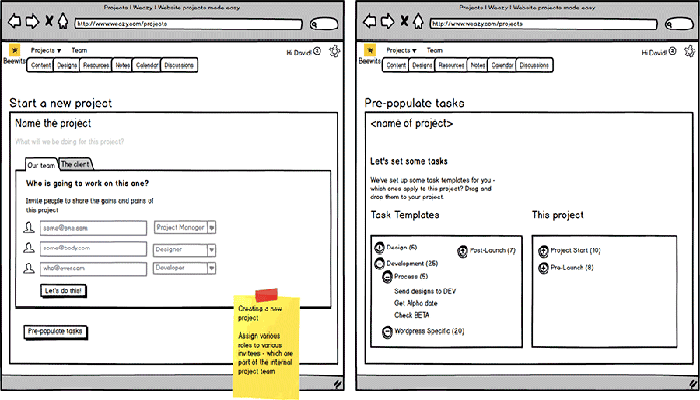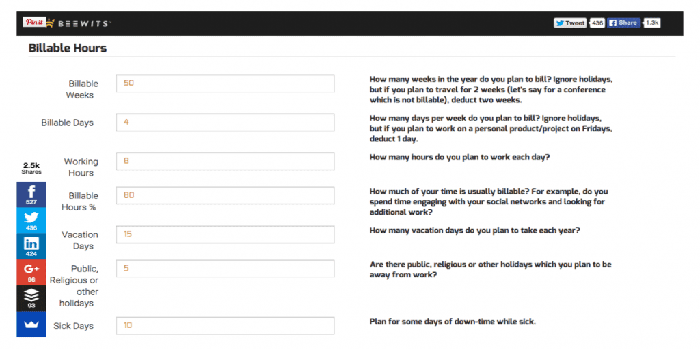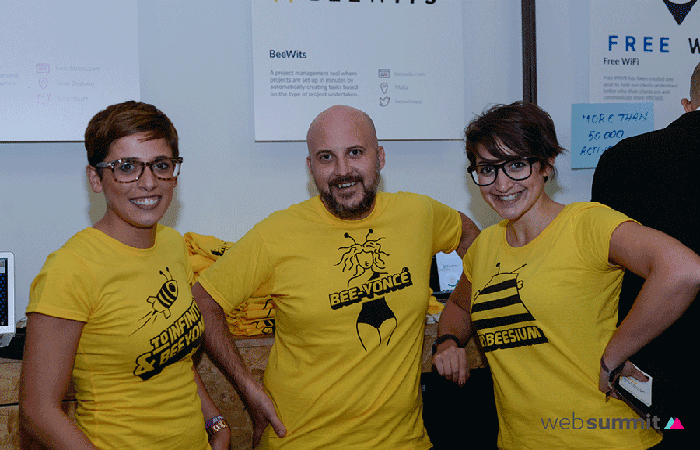A few months back, Richard Muscat Azzopardi, a co-worker I knew from a previous job, approached me with an interesting proposal. Whilst setting up Switch Digital Ltd – a digital marketing agency – he ran into a few organisational problems.
Of course, like we all do, he turned online to look for a solution for his nagging issues – and was surprised to find there seemed to be no software solutions to address these problems.
As an experienced Product Manager, Richard offered me the opportunity to build a solution for these problems for Switch Digital, and of course in the process, build it for the rest of the world.
This is part of our story.
Whilst developing BeeWits, which is about to start inviting users for our Early Access program, we learned quite a few things. Here’s what we learnt. The good stuff. And the times where we might have fucked up.

The Idea + The Research
1. The Web Design industry is alive and kicking, and generates at least $20.1Bn in the US economy alone (Source: Yahoo).
2. There are many people who face organizational issues like us. When we reached out to fellow web designers like us, we learnt that organizing of projects is a serious headache for many agencies and freelance designers.
3. Research – make sure your idea is not saturated with competitors. There’s always room for competition, but the market has to be large enough to sustain all of you competing for it.
4. If you’re going for a saturated market, make sure you have a few unique selling points which will hit the spot for the niche you’re targeting.
5. When reaching out to people like yourself – particularly with an idea for a solution, you’ll get plenty of people who are in the same problem as you are. Converse and discuss.
6. If you don’t get any feedback, or people who face the same problems as you – then you might want to rethink your “next big thing”.
7. Test the waters. Before rolling up your sleeves to develop a solution – cheat a bit. Design a page as if your solution existed and ask for an email address. If after driving traffic to your site, a significant number of people give you their email address – good! You’re on the right track. There are other great tips at The Lean Startup – get the book and read it.
8. Test the waters some more. Now that you know that some people are interested in your proposed solution – see whether they are ready to pay for it. Add a pricing tab with gut feel prices. See whether people click to see the pricing and still give your their email address. If they still give you their email address in significant numbers, then there is potential in the market for your solution.
(Hint: Use Google Analytics Click goals to monitor clicks)
9. Read, read and then read some more. There are hundreds of great people out there giving excellent advice. You’ll recognize the experts from the trash when you learn amazing stuff you would never have thought of. YCombinator how to start a startup is an excellent starting point. So is Reddit/r/startups
10. Take notes. Especially of the excellent ideas. Stickies are fine. A whiteboard. A real paper notepad. You’ll be plenty busy, and if you don’t write you’ll forgot a few good ideas.
The development of BeeWits
11. We bootstrapped (and self-funded) the development of BeeWits. Make sure your company is able to fund itself and the development of a product.
12. Identify a target demographic and build towards that demographic only. You may have plenty of ideas and see tonnes of potential – but start with laser focus on one demographic and make sure you get that right.
13. Start small. Build a Minimum Viable Product – a product which is small enough to provide value to your target demographic but not large enough to bust all your budgets.
14. Estimate a development time with your developers. Multiple the estimate by at least two and ideally three. Developers are surprisingly over optimistic. You’ll run into other problems too so prepare yourself.
15. If you’ve got a good development partner company and excellent communication with them – off sharing development is a good budget-conscious idea. Don’t offshore to people who you don’t know, unless you’re ready to dump everything and start from scratch with a new partner.
16. Make sure communication with your developers is spot on. Language barriers can create serious problems all over the place.
17. Node.js developers are severely in demand. If you have a choice, you might want to avoid it unless you’ve got a deep pocket and are prepared for turnover issues.
18. Staff turnover will severely impact your project timelines, especially for small development teams. Seriously consider making your developers founding partners.
19. Mocking up ALL screens is the best way to spec a project. Visuals with accompanying text go a long way in taking an idea from a concept to a working screen.

20.Push your suppliers for better prices. You’re a startup, use it to your advantage.
The marketing + the exposure
21. Build it and they will come is a fallacy. It *might* work if you’ve got millions of VC dollars to burn through and are super well-connected.
22. Start marketing your solution from day one. Seriously. You have to put as much work into marketing as much (if not more) as you do into development.
23. Write epic blog posts for your target demographic. Find a problem and fix it for them. Share the idea. Such as the Ultimate Web Design Checklist.

24. Google+ is not dead. It sends SEO signals too. Mark my words.
25. Good design goes a long way in establishing trust. Spend time and money on making your site, blog, and everything else which is public look pretty.
26. If you’re not spending more time promoting your great content than writing it – you’re doing it wrong.
27. Your only marketing aim whilst developing your product should be getting the email address of users in your target demographic.
28. Tools such as SumoMe go a long way in collecting email addresses. Offerring a free ebook in exchange for an email address is a surprisingly effective method.
29. Offering a download bundle which is useful for your target demographic for the “price” of an email address is also a surprisingly effective method. You might want to get our 101 Free Fonts or our Web Design Contract bundle.
30. Once you’ve got email addresses – make sure you keep your users engaged with consistent targeted mailings and content.
31. Building small free but helpful tools for your target demographic can be a very good source of driving traffic to your sites.

32. Outreach is hundreds of times more effective using these helpful tools as opposed to blog content.
33. Don’t forget to create a privacy policy and abide by it. People like to be reassured their email won’t be sold to spammers.
34. Use email outreach or Contact Us pages to get in touch with people who are likely to feature your blogs.
35. Make outreach emails all about them. Butter them up, be very contextual and topical to their sites, and be very very brief. Read about sending outreach emails and use something which works well for you.
36. Warm people up to your outreach by establishing a relationship via social networks, commenting on blogs works wonders for your outreach. Incidentally, have you joined BeeWits on Facebook and Twitter?
37. Use voilanorbert.com and Findthat.email to find the exact email address of people you want to contact.
38. Use SideKick to know when your emails have been read (and ignored).
39. Follow up after two weeks with people who have not replied.
40. Sometimes you’ll get links without getting a reply. Pat yourself on the back for all those times when you were completely ignored.
41. Do not get discouraged when you are ignored. It’s a game of numbers. Some people will reply. Some won’t. It’s a fact of life.
42. Try going for the big fish if you’ve got a very good free tool. You’ll be surprised at your success rate. We’ve been featured by Creative Bloq, LifeHacker, DesignTaxi and Fast Company Design, and Co.Drops.
43. If your success rate is abysmal – you might want to go back to the drawing board. Is your tool REALLY as good as you think or … ? Does it have awesome design?
44. Maintain a good relationship with anybody who replies to you. When you’ll need them again, it will be easier to reach out and get results.
45. Attend conferences. You’ll learn lots of stuff especially if you speak to your potential customers. You might meet investors too. Free t-shirts work wonders.
The Launch
46. Plan a viral giveaway with a prize your target demographic will kill for as part of your launch. Spend as much money as necessary getting it right.
47. Use good communication with your leads. Intercom seems to be a very nice tool for us.
48. Use onboarding tools to guide your users. There’s plenty of good libraries and services. We’re using Hopscotch but there are plenty of others.
49. Start onboarding users slowly. Don’t get overenthusiastic and invite few people at a time. Listen to what your customers say.
50. Don’t let perfect get in the way of done but don’t leave obvious ugly bugs.
The Revenue Ramp Up
51. Contrary to what you might have heard, converting clients to a recurring revenue service is harder than converting for one-off products. A 3% conversion ratio is fair, 5% and you’re doing great.
52. Make sure that your subscription prices work in favour of your clients, not in favour of your bottom-line. You’re looking to establish a long-term relationship with your clients, with minimal churn.
53. Handling subscriptions is a complex use-case which you should not endeavour to build yourself. Interface with a payment gateway or opt for a subscriptions plugin such as the ones listed here.
54. Make sure your support is absolutely top-notch. Your clients need to feel fully at ease if you want to keep them long-term. A long-term client also increases the LTV (lifetime value) average, allowing you to spend more on marketing and sales.
55. If at first you don’t succeed, iterate and improve. Get feedback from your clients and implement some of their best suggestions. You’ll find that feedback in general will return mostly the same comments, so it’s fairly easy to prioritize your development.
56. If you still don’t succeed – pivot. There are plenty of ways to monetize your service, or blog traffic, particularly if you’ve done the marketing right. As long as you provide value, your readers will be happy to take your advice.
We’ve learnt lots more, and we’ll surely be sharing more of these tips in the future. In the meantime, we’d love it if you would sign-up to the BeeWits for a 30-day trial. If you’re into web design – you’ll be happy and you’ll make us happy!
This is the sort of great stuff we do at Switch Digital, not just for us but for our clients too!





